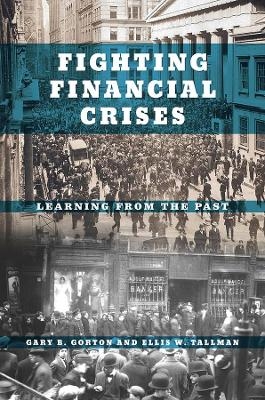
Fighting Financial Crises
Learning from the Past
Seiten
2018
University of Chicago Press (Verlag)
978-0-226-47951-4 (ISBN)
University of Chicago Press (Verlag)
978-0-226-47951-4 (ISBN)
A history of the effort to fight financial crises, from the mid-nineteenth century to the present.
If you’ve got some money in the bank, chances are you’ve never seriously worried about not being able to withdraw it. But there was a time in the United States, an era that ended just over a hundred years ago, in which bank customers had to pay close attention to whether the banking system would remain solvent, knowing they might have to rush to retrieve their savings before the bank collapsed. During the National Banking Era (1863–1914), before the establishment of the Federal Reserve, widespread banking panics were indeed rather common.
Yet these pre-Fed banking panics, as Gary B. Gorton and Ellis W. Tallman show, bear striking similarities to our recent financial crisis. In both cases, something happened to make depositors—whether individual customers or corporate investors—“act differently” and find reason to question the value of their bank debt.
Fighting Financial Crises thus turns to the past for a fuller understanding of our uncertain present, investigating how panics during the National Banking Era played out and how they were eventually quelled and prevented. Gorton and Tallman open with a survey of the period’s “information environment,” tracing the development of national bank notes, checks, and clearing houses to show how the key to keeping order was to disseminate information very carefully. Identifying the most effective responses based on the framework of the National Banking Era, they then consider the Fed’s and the SEC’s reactions to the recent crisis, building an informative new perspective on how the modern economy works.
If you’ve got some money in the bank, chances are you’ve never seriously worried about not being able to withdraw it. But there was a time in the United States, an era that ended just over a hundred years ago, in which bank customers had to pay close attention to whether the banking system would remain solvent, knowing they might have to rush to retrieve their savings before the bank collapsed. During the National Banking Era (1863–1914), before the establishment of the Federal Reserve, widespread banking panics were indeed rather common.
Yet these pre-Fed banking panics, as Gary B. Gorton and Ellis W. Tallman show, bear striking similarities to our recent financial crisis. In both cases, something happened to make depositors—whether individual customers or corporate investors—“act differently” and find reason to question the value of their bank debt.
Fighting Financial Crises thus turns to the past for a fuller understanding of our uncertain present, investigating how panics during the National Banking Era played out and how they were eventually quelled and prevented. Gorton and Tallman open with a survey of the period’s “information environment,” tracing the development of national bank notes, checks, and clearing houses to show how the key to keeping order was to disseminate information very carefully. Identifying the most effective responses based on the framework of the National Banking Era, they then consider the Fed’s and the SEC’s reactions to the recent crisis, building an informative new perspective on how the modern economy works.
Gary B. Gorton is the Frederick Frank Class of 1954 Professor of Management and professor of finance at Yale University School of Management and a research associate of the NBER. He is the author of many books, including, most recently, The Maze of Banking: History, Theory, Crisis. Ellis W. Tallman is executive vice president and director of research at the Federal Reserve Bank of Cleveland. He has published extensively on macroeconomics, economic forecasting, and historical episodes of financial crisis in several top journals.
| Erscheinungsdatum | 18.09.2018 |
|---|---|
| Zusatzinfo | 14 line drawings, 12 tables |
| Sprache | englisch |
| Maße | 152 x 229 mm |
| Themenwelt | Geschichte ► Teilgebiete der Geschichte ► Wirtschaftsgeschichte |
| Wirtschaft ► Volkswirtschaftslehre ► Finanzwissenschaft | |
| ISBN-10 | 0-226-47951-X / 022647951X |
| ISBN-13 | 978-0-226-47951-4 / 9780226479514 |
| Zustand | Neuware |
| Haben Sie eine Frage zum Produkt? |
Mehr entdecken
aus dem Bereich
aus dem Bereich


